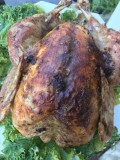Chef's knife buying guide. What to look for in a chef's knife.
whustoff...my favorite!
Choosing a chef's knife
Oh it's too easy to become seduced by the latest cooking gadgetry, and too many of us have drawers of forgotten clutter…purchases that seemed like a great idea at the monument, yet were never destined to really star in the show.
On the flip side, far too many people make do with poor quality knives, when this is the singular most important kitchen tool. If you do not yet own a good quality chef's knife, restrain yourself from all other kitchen purchases until you can justify a good 100$ or more chef's knife. You will never regret it and it will last you a lifetime.
Forget about those tempting full (10 or more blades!) knife sets conveniently sold in a knife block and all for $29.99…it's cheap crap, it won't work well, you’re more likely to cut yourself with it, it won’t hold an edge, and it will forever slow you down. You don't need 10 knives anyway…a chef's knife will do it all.
Cooking professionally, I probably use my chef's knife 1000 times for every 1 time I reach for a paring or boning knife, and if I had to, I could forget about those other knives altogether and simply use my trusty, much loved, 12 year old Wuhstoffs classic!
Old school or new….German or Japanese?
While a decade ago all professional chefs wielded the heavy and substantial, and very good quality German type of knife, a significant percentage have eloped to the new fangled Japanese style of knife. The Japanese (Global Knives is the most famous of the brands) are made with a much harder type of steel, and the blades are much thinner, can be much sharper, and are substantially lighter.
The disadvantage of the Japanese models is that they are a bit harder to sharpen, but some cooks really love the light weight and surgical precision of the Japanese scalpel sharp knives.
It's a matter of preference and comfort, some people like the substantial heft of the German's (me) and some prefer the sharp, lightness of the Japanese. Hold them both and see which feels more comfortable.
Look for:
Full tang
You do want the knife to be a full tang handle type. This means that the blade extends all the way through the handle as one solid single piece of steel. This makes the knives virtually indestructible, and the handle will never separate from the blade.
Forged steel
You also want forged steel. This means that the blade was "forged" from a single piece of steel and pounded under heavy weight and high heat into the shape. This method of making a knife is more expensive, and only better knife manufacturers will use forging in production. A forged knife will hold a cutting edge far better than a cut or stamped knife.
Balance
A chef's knife should feel balanced in you hand. If you hold the knife palm up with two fingers at the bolster (the strip of metal between the blade and the handle) does it feel nicely balanced in your hand? If it doesn’t…it's not the right knife for you.
High carbon stainless steel
The best cutting edges are actually made with carbon steel, but this type of blade does rust and discolor, and is not popular or common as a result. High carbon stainless steel is a good second choice, will hold an edge very well, and will require virtually no maintenance save for an occasional sharpening.
It is really worth the money, and if you do not already own a quality chef's knife…what are you waiting for!?!










